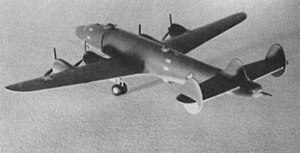Lockheed XB-30
| Lockheed XB-30 | |
|---|---|

| |
| Scale model of the Lockheed XB-30 bomber concept. | |
| Role | Heavy bomber |
| Manufacturer | Lockheed Corporation |
| First flight | n/a |
| Status | Design only |
| Primary user | United States Army Air Forces |
| Number built | 0 |
| Developed from | Lockheed Constellation |
The Lockheed XB-30 (company model L-249)[1] was the design submitted by Lockheed after the request by the United States Army Air Forces for a very heavy bomber, the same request that led to the Boeing B-29 Superfortress, the Douglas XB-31 and Consolidated B-32 Dominator.
Design and development
Around 1938, General Henry H. 'Hap' Arnold, the head of the Army Air Force, was growing alarmed at the possibility of war in Europe and in the Pacific. Hoping to be prepared for the long-term requirements of the Air Force, Arnold created a special committee chaired by Brigadier General W. G. Kilner; one of its members was Charles Lindbergh. After a tour of Luftwaffe bases, Lindbergh became convinced that Nazi Germany was far ahead of other European nations.
In a 1939 report, the committee made a number of recommendations, including development of new long-range heavy bombers. When war broke out in Europe, Arnold requested design studies from several companies on a Very Long-Range bomber capable of traveling 5,000 miles (8,000 km). Approval was granted on 2 December 1939.
Based on the design of the Lockheed L-049 (adopted by the Army Air Force as the C-69), the L-249 never progressed past the design stage, mainly because Boeing had a huge head start with its Boeing B-29 Superfortress. Only a scale model was built. Retaining the wings and tail surfaces of the Model 49, the Model 249-58-01 was to have had a new fuselage with up to six gun turrets (one in the nose, two above and two below the fuselage, and one in the tail) housing 10 .50 calibre guns and one 20-mm cannon. Ventral bomb bays were to accommodate eight 2,000-lb. (907 kg.) bombs.
Specifications (as proposed)
General characteristics
- Crew: 12
Performance
Armament
- Guns:
- 8× .50 in (12.7 mm) machine guns in four fuselage turrets
- 2× .50 in (12.7 mm) machine guns and
- 1× 20 mm cannon in tail barbette
- Bombs: 16,000 lb
See also
Related development
Aircraft of comparable role, configuration, and era
Related lists
References
- Notes
- ^ Stringfellow and Bowers 1992, p. 31.
- Bibliography
- Stringfellow, Curtis K., and Peter M. Bowers. Lockheed Constellation. St. Paul, Minnesota: Motorbooks, 1992.
